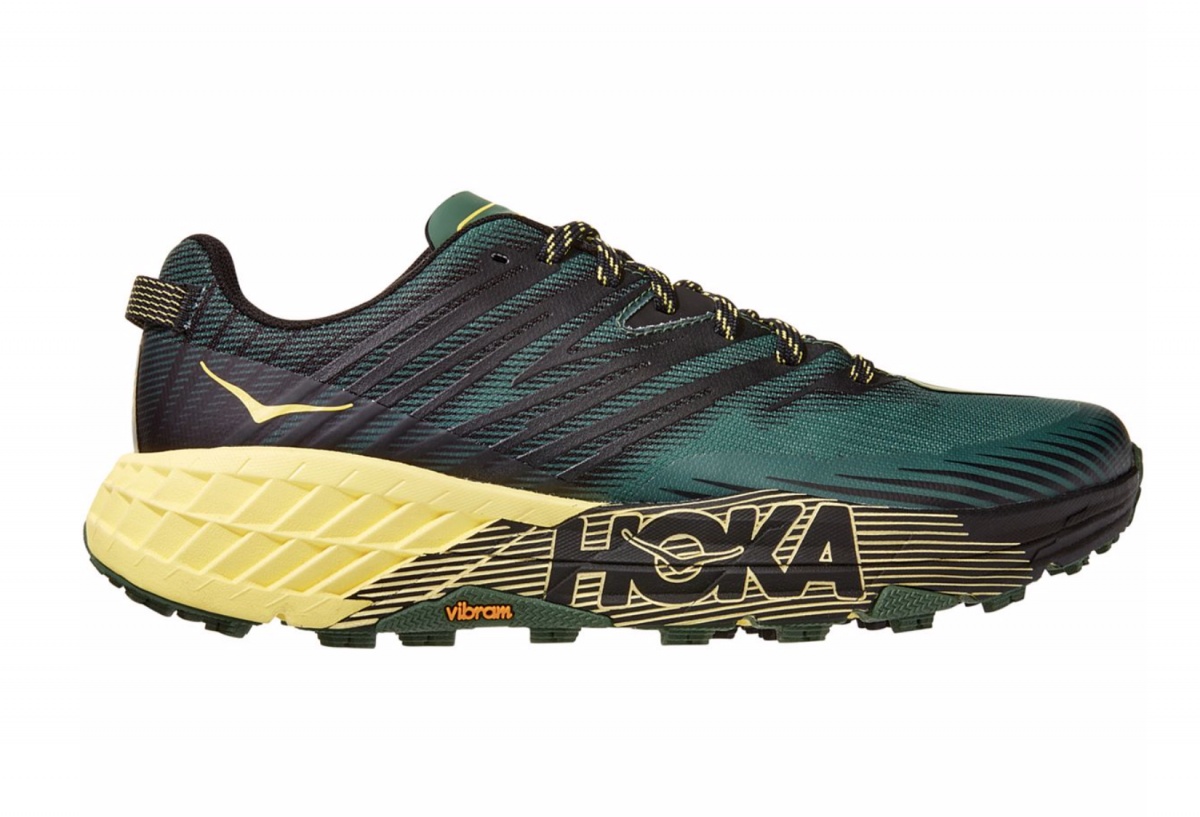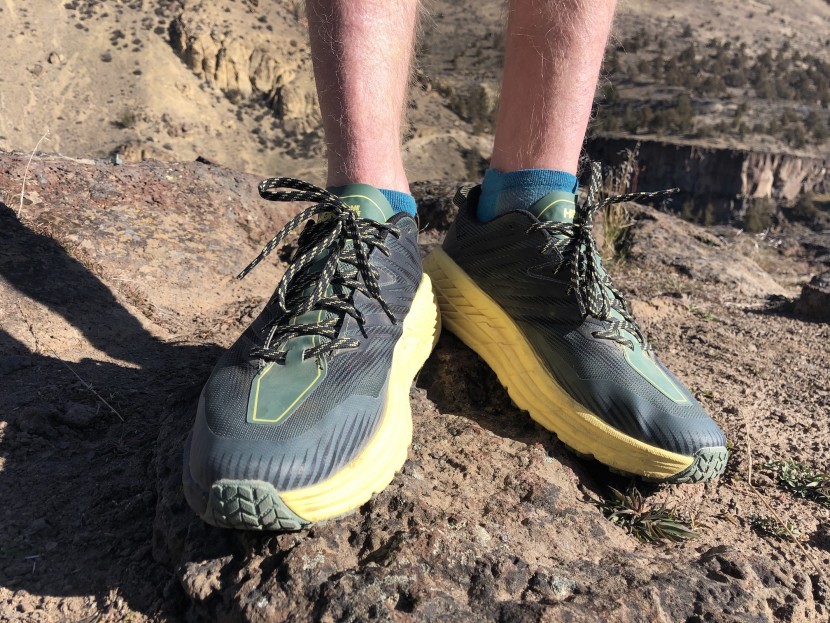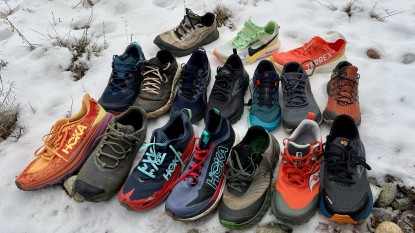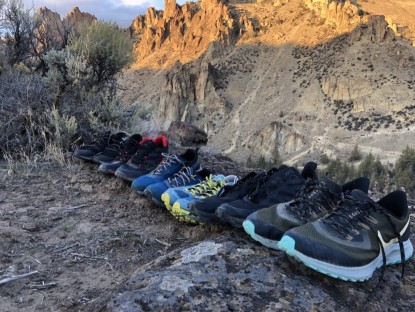Hoka Speedgoat 4 Review
Our Verdict
Our Analysis and Test Results
All Hoka shoes have a ton of underfoot cushioning in the form of EVA foam, and the Speedgoat 4 is no different. With a 32mm stack height under the heel, suffice to say that this shoe's midsole gets the job done plenty well without the need for even more foam, as is found in some other Hoka shoes. It has a 4mm heel-toe drop, 1mm less than most other Hoka trail runners. However, what sets this shoe apart is the Vibram Megagrip outsole, made by the same company that manufactures the outsole used in many climbing shoes. This rubber compound is very sticky and grips exceedingly well to either wet or dry rock. The deep lugs ensure that it also grips well on slippery and loose terrain. While it's pretty similar in most important aspects to other beefy Hoka shoes, the traction is why we think this is one of the best.
The Speedgoat 4 updates the previous 3 in small and subtle ways. Generally speaking, the design remains mostly unchanged, with the same stack height, heel-toe drop, and outsole pattern. The upper is made of thinner and more breathable material, and the shape is ever so slightly wider but still trends toward a narrow fit, particularly in the forefoot and toe box. It comes in EE-wide sizes now for those with wide feet. The midsole foam compound has been changed slightly, although it was nearly impossible for us to tell the difference by comparing the two versions on different feet. The tongue is now a thin piece of fabric without padding. Most notably, the weight has increased to the tune of roughly 0.5 ounces per shoe. Still, we think those who loved the previous version will also be happy with this one.
Foot Protection
This shoe is one of the most protective you can buy, especially for the undersides of the feet. The 32mm of EVA foam under the heel does an incredible job of dampening the effect of stepping on sharp or uncomfortable protrusions such as rocks and scree, although you can still feel a slight sensation. To sum it up, you can feel you are stepping on things in these shoes, but you won't be able to tell that they are sharp. While Hoka claims to have tweaked the recipe for the EVA foam to make it more responsive, the fact is that we have a hard time telling the difference between it and older versions in side-by-side testing.
There is very little toe bumper on this shoe besides a simple 3D print overlay, although the rockered geometry of all Hoka shoes does a pretty decent job of minimizing the frequency of kicking rocks. The upper material is a thinner but seemingly more durable version of reinforced mesh with 3D print overlays in the most critical wear areas, but it doesn't do a ton to protect the actual sides of the feet. We find we don't need this protection as much in these shoes riding as high off the ground as they do. While not the absolute most protective, foot protection is nevertheless these shoes' strongest attribute.
Traction
We like the Vibram Megagrip outsole rubber found on this shoe better than any other Hoka shoe. The main reason is that it's very sticky, which helps it grip rock, either dry or wet. Since we love to run where it's rocky, we appreciate a soft and sticky rubber that isn't too hard and grips well. The outsole is littered with 5mm deep lugs with their own unique shape. These pronounced lugs are pretty durable and not overly prone to ripping off, although they do begin to wear down over time, as you would expect of most soft rubber soles.
The sharp-edged lugs do an excellent job biting into soft and loose surfaces such as loose dirt, grass, and snow. We also think they grip nicely on mud but still experienced some pretty epic caking on one mid-winter trail run where we encountered persistent mud. This finding suggests that they could stand to be spread out slightly more. Minor complaints aside, traction is not something you will have issues with while wearing this shoe.
Sensitivity
No matter what type of terrain you are running over, there is very little trail feel to be experienced with these shoes. We found that on the very roughest of trails, where we were constantly stepping on rocks and scree, we experienced some sensation in our feet, but by and large, this sensation was severely dampened.
There is no rock plate sandwiched into the layers of foam, but the foam itself is so deep and plush that it's not necessary to insulate the foot from the ground effectively. Runners who value sensitivity over foot protection are barking up the wrong tree if they consider this shoe and would be better off with something like the Saucony Peregrine 11.
Stability
Compared to low riding, zero-drop alternatives, Hoka shoes are not exactly the most stable. It is understandable when you look at them, as their underfoot platform is 32mm tall! Any time you are moving your foot that far above the ground, stability will be compromised, and this is the essential trade-off that one must choose to pay when looking for maximum cushioning.
That said, we think the Speedgoat 4 is quite possibly the most stable Hoka we have worn. It grips the foot securely to avoid slipping around on the inside and combines a wide landing platform with a low heel-toe drop. Over time, we've also realized that it becomes possible to adapt to anything you use frequently, and we don't find that most Hoka users have too big a problem with stability. We notice it the most when on steep, uneven terrain such as grass hummocks off-trail or when running in a washed-out trail that has eroded into a v-groove without a flat landing spot in the bottom. On standard trails, even rocky ones, where we find a relatively flat landing spot, the added stack height isn't generally a big deal.
Comfort
We find this shoe to be very comfortable. Hoka claims that they made the toe box slightly wider than previous versions, as many people complained it was too narrow. There is no doubt that this toe box is still on the narrow side and tapers to a point in the front that isn't shaped like a foot. However, the heel also seems to fit a bit narrower, which helps grip the foot better, an issue we noticed with previous versions. Overall, we think the fit on the Speedgoat 4 is excellent, and those with wider feet can order a wide version. There is no need to size up or down.
This shoe's upper construction quality is excellent, with a seamless interior on the upper that has no obvious rub points. The tongue is now a thin piece of material that does less to pad against the pressure of the laces, but we never felt any discomfort from this. The only downside is that we noticed that the shoe absorbs more water than the previous version in our water bucket test, despite being made of thinner material. It also doesn't shed that water as quickly. So if you want a shoe for the very wettest of daily runs, this may not be the top choice, but it is pretty comfortable regardless.
Weight
Our pair of size men's 11 weighed in at 23.6 ounces on our independent scale. For reference, the older Speedgoat 3 weighed 22.5 ounces, so we logged an increase in weight of roughly half an ounce per shoe.
The Speedgoat 4 saw adjustments to both the midsole foam and the upper, which combined make up most of the shoe. Any drastic changes are sure to have repercussions on the weight, but we are, of course, a bit bummed that the increase is so much. It is now one of the heavier choices that we have featured in our review, and yet, considering the size of the shoes themselves, we are still impressed that they aren't heavier.
Should You Buy the Hoka Speedgoat 4?
The Speedgoat 4 is a great footwear choice because it's comfortable, performance fitting, and has some of the grippiest traction of any maximally cushioned shoe we have worn. Despite adding a little weight over the previous version, we feel the fit is enhanced to provide even better performance. If you are in the market for super thick, absorbent cushioning, this is where we recommend you begin your search.
What Other Trail Running Shoes Should You Consider?
Like most Hoka shoes, these are not cheap. However, we think that the price you will pay for these is not totally out of line considering their performance. We've found that the thick foam in these shoes tends to last for hundreds of miles without becoming too played out, and we feel that the Speedgoat 4 presents decent longevity and solid performance. If you are in the market for maximum cushion trail shoe but aren't entirely sold on the Speedgoat, you can take a look at the Hoka Challenger ATR 6, which scored higher due to its lighter weight and a slight increase in stability. The Salomon Sense Ride 4 is another excellent option that offers a much better sensitivity score than either of the Hoka models.













